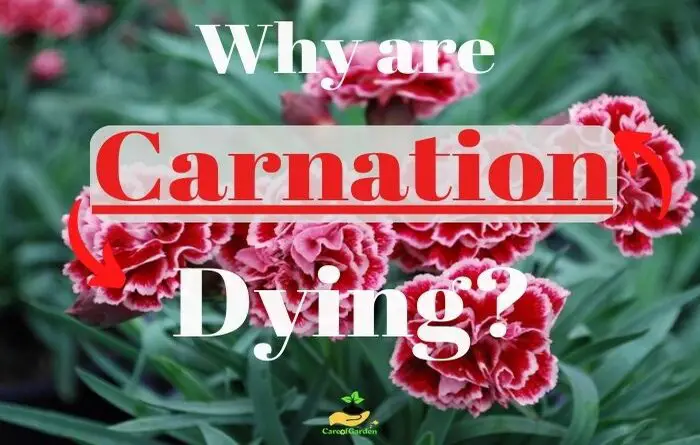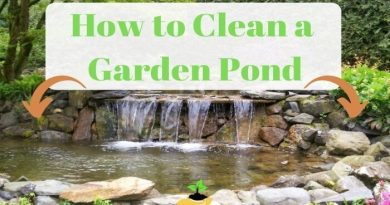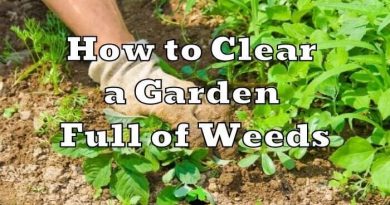Why is Carnation Dying? (Quick Answer Here)
Carnation or clove pink are known for their bright, colorful blooms and long-lasting beauty. They are relatively easy to grow, but like all plants, they can sometimes experience problems that could lead to their death. In this post, we will explore some of the most common reasons why carnation is dying and provide a few solutions before it’s too late.
Your Carnations known also as clove pink may be dying due to several factors, including overwatering or under watering, poor soil quality, pest infestations, or disease. In some cases, it may be a combination of these factors that are causing the plant to struggle. By identifying the specific issue and taking appropriate measures, such as adjusting watering habits, improving soil quality, or treating for pests or disease, gardeners can often revive their dying carnation plant.
Why Is My Carnation Dying?
Here are three of the most frequent causes behind a dying carnation along with their remedies.
1. Different Forms of Plant Diseases
Carnations can catch diseases pretty quickly. And if you notice it late, it can cause irreversible damage to the plant.
There are some diseases and infections that most commonly occur in carnations. Let’s take a look at five of the most common ones followed by their treatments.
Bacterial Soft Rot
In this particular disease, you will notice that the leaves will develop spots, get moldy and turn soft and change their color to black or gray. You may also notice watery blotches and cankers on the stem, flowers, and leaves.
As the name suggests, it is caused by bacteria that attack the tissue of the plant. The entire Vascular system of carnation turns mushy and wilts and changes to yellow color. This indicates that the plant is dying.
The carnation lags behind in growth, the tops of the shoots become dull gray and wither, the upper leaves shrivel and the root system dies off.
Solution
This can be cured during the early stages of the disease. If the rot spreads throughout the entire vascular system of the plant, then it might be next to impossible to salvage the existing plant.
As bacteria thrive in high humidity levels, ensure that your plant is not exposed to more than needed humidity or watering. Regularly check the plant for any early-stage signs.
Moreover, you can also use chemical-free insecticide spray or neem oil, etc to disinfect the plant itself. In case you notice a dying growth, prune it off.
Armillaria Root Rot
Also known as the Oak root fungus that usually attacks perennials and woody plants like carnations. This particular fungus attacks the vascular tissues and spreads from there. Some visible symptoms include discoloration in the stem that eventually starts to wilt and collapse.
Solution
As there is no external attack, no physical remedy helps. In this case, simply make sure that the soil the plant is planted in is well draining and that you are watering the plant properly.
Furthermore, if a new plant is being planted make sure any old remnants of the plants are completely removed to avoid spreading the infection.
Fusarium Wilt
This is also called Basal rot. This is a type of fungal infection that is usually found in herbaceous plants. The early signs of infection are the carnation leaves wilting and turning yellow before eventually changing to a brown color and dying starting from the bottom of the plant.
It occurs a lot commonly in younger carnations, which usually die.
Solution
This fungus attacks when you are not taking proper care of the plant. Common practices for taking care of the carnations including their environmental factors and requirements need to be taken into consideration.
If your plant exhibits signs of a Fusarium Wilt, look for what practice are you doing differently or not following properly. Similarly, ensure you have w well-draining system, water, light, and correct fertilizers are being given to the carnations.
Rhizoctonia Rot
This is a type of fungus that attacks the stems of a carnation. You will mostly find it in conditions of higher temperature and humidity, so it usually infects during the flowering season.
The fungus is found in the soils and is transferred to the other parts of the plants via air or fungus gnats.
The first physical sign is yellow, wilting leaves like many other diseases. The fungus forms a barrier between the roots and the shoot system. Due to this, the upper half of the plant does not get any nutrients or water and it dies of thirst.
Solution
Realistically, once your carnations catch a stem rot it are not salvageable. You can take preventative measures. Sterilize all the tools you are using as well as the soil. Frequently use fungus soil drenches so that fungus does not infect the soil.
In case you notice the signs of this disease, separate the plant from the rest of your plant babies. As this can spread you do not want an infected plant near your healthy ones.
You can try pruning off the dead parts, but at this point, there is nothing much you can do.
2. Pests
Carnations, like many other plants, are susceptible to a variety of pests that can cause significant damage to the plant and even lead to its death.
One of the most common signs of pest infestation in carnations is the presence of distorted or discolored leaves. Pests such as aphids and spider mites can cause carnation to become yellow, brown, and if left untreated, to die.
Aphids
Sucking insects are greenish, red, black or peach in color. Aphids spread disease through their piercing-sucking mouthparts. Insects leave a sticky residue on the foliage that attracts ants.
Aphids have natural enemies, these are ladybugs and hoverflies. In open ground, you can attract them to the garden by planting fennel, dill, carrots and parsley. And fragrant lavender repels aphids. You can wash off insects from plants with a strong pressure of water.
Spider mites
They are tiny arachnid pests of pink cloves and other crops. Ticks can be red, black, brown or yellow. Pests suck out the juices of plants, while introducing toxins. Because of them, the foliage turns yellow, becomes dry and is covered with spots. Insects reproduce rapidly and thrive in dry conditions.
In order to prevent the development of an insect, it is worth regularly inspecting the plants and removing suspicious leaves.
Spider mites can be fought with strong water pressure every other day and treatment with soapy water. This method is good for indoor plants.
Thrips
These are tiny insects of black or straw color. They suck the juices of plants and attack the petals, leaves and stems of flowers. The plant will have a speckled or discolored blotch on the leaf surface. Thrips can transmit many diseases from plant to plant.
To prevent the appearance of thrips in the garden, in the fall, all plant debris and weeds are removed, as pests may remain on them for the winter.
Pests can be washed off with strong water pressure.
3. Poor Watering Habits (Too Much or Too Little)
Carnations have specific water requirements, which is basically not too much water. The plant can easily become waterlogged and that is definitely a straight path for it to die. Too much water will cause the leaves to start wilting and turn yellow. Excess water can also cause rot throughout the plant.
Underwatering the plant is also going to kill it. The growth will stop and you will notice the leaves of the plant lose their shape and color and die.
Too much water
Overwatering is also one of the common reasons why carnations die. Carnations are plants that don’t like being overwatered because its roots become waterlogged and can’t get the oxygen they need to survive.
The leaves may also start to droop and curl, and the stems may become weak and brittle. In severe cases, the plant may start to turn brown and die.
It’s important to allow the soil to dry out slightly between waterings, as too much moisture can cause the roots to rot.
It is necessary to adjust the watering schedule and be sure to drain the water from the pan after each watering to prevent moisture stagnation near the roots.
This will help prevent further waterlogging and give the plant a chance to recover.
Solution
Carnations do not need a lot of water. If the soil is dry, only then water the plant. Moreover, make sure that the soil is airy so it doesn’t trap water and that you have a proper drainage system.
Ensure that you are not flooding the plant or keeping it thirsty. It is the only way to prevent it from dying. Stick to a schedule and only water when needed.
Lack of water
Lack of water or under watering is a leading cause of plant death, and carnations are no exception. When a carnation receives insufficient water, its roots dry up and die, causing the plant to wither and finally die. Understanding the warning symptoms of under watering and how to avoid it is essential for keeping carnations healthy and colorful.
Wilting is the first indicator of under watering in a carnation. As the plant attempts to conserve water, its leaves and stems will begin to droop and curl inward.
The leaves may also become yellow or brown, and the flowers may wilt and fall off before they should. In extreme circumstances, the entire plant may dry up and die.
Solution
If a carnation starts showing lack of water symptoms , it’s important to act quickly. The plant should be watered deeply and allowed to drain. It’s also a good idea to mist the leaves with water to help the plant absorb moisture. However, it’s important not to overwater the plant, as this can lead to other problems.
Water the carnation deeply once a week to ensure that the water reaches the roots. Allowing the soil to dry out somewhat between waterings is vital, since too much moisture might cause the roots to rot.
4. Improper Location & Soil
It is very important to make sure you are planting your carnations in the correct location. They are sun-loving plants and need a good amount of sunlight.
Hence they will not thrive in shaded areas. Furthermore, they can also not thrive in areas that are very dusty. Dust clogs their spores in the leaves, which hinders the process of photosynthesis. No food will lead the plant to die off.
The quality of soil is one of the most important factors in determining the health and vitality of a carnation plant. Poor soil quality can make carnations more susceptible to disease, pests, and environmental stresses, which can ultimately lead to the plant’s death.
Firstly, poor soil quality can prevent carnations from getting the nutrients they need to thrive. Soil that lacks essential nutrients such as nitrogen, phosphorus, and potassium can cause the plant to become stunted and weak. This can lead to a lack of flowers, slow growth, and eventually death.
Secondly, poor soil quality can make the plant more susceptible to pests and diseases. Carnations growing in soil that is too acidic or alkaline may be more prone to fungal diseases and insect infestations. Similarly, soil that is too compacted or lacks proper drainage can promote the growth of harmful bacteria and fungi.
Thirdly, poor soil quality can make it difficult for carnations to absorb water. Soil that is too sandy or too heavy can make it difficult for the plant’s roots to absorb moisture. This can cause the plant to wilt, become dry and brittle, and eventually die.
How to Resolve the Issue
Check to see if the plant is not potted in a dusty or shady area. Place the plant where it can breathe properly and receive a good amount of morning and evening sunlight.
To prevent poor soil quality from affecting your carnations, it’s important to ensure that the soil is rich in nutrients and well-drained. This can be achieved by adding organic matter such as compost, leaf litter, or well-rotted manure to the soil.
It’s also important to test the soils pH levels to ensure that they are within the optimal range for carnations.
5. Environmental Factors
Carnations can be sensitive to extreme temperatures and direct sunlight. Exposure to high temperatures or strong sunlight can cause the plant to wilt or scorch, which can eventually kill it.
- Extreme temperatures: Carnations are sensitive to extreme temperatures, and exposure to hot or cold weather can cause them to die. If the temperature is too high, the plant can wilt and lose its leaves. Similarly, if the temperature is too low, the plant can suffer from frost damage and also be fatal.
- Direct sunlight: Carnations prefer bright but indirect light, and exposure to direct sunlight can cause the flowers to wilt and the leaves to scorch. This can eventually lead to the plant’s death, especially if it is left in the sun for an extended period.
- Humidity: Carnations are susceptible to fungal diseases, and high humidity can create an environment that is conducive to the growth of fungi. This can cause the plant to develop diseases such as Fusarium wilt, which can kill the plant.
How to prevent carnation from dying
| Diseases and Pests | Carnation Symptoms | How to prevent carnation from dying |
|---|---|---|
| 1.Bacterial Soft Rot | Carnations turn brown, wither and die | Destroy the plants and do not replant in the same place. |
| 2.Fusarium Wilt | It manifests itself in the form of withering of the roots and the base of the stem, individual shoots become discolored and die. | Cultivation of resistant varieties, planting carnations next to the petunia (in a row). Preventive spraying of plants in the open field with a 0.5% solution of copper oxychloride or other copper-containing preparations every 10-12 days. |
| 3.Rhizoctonia Rot | A fungal disease that causes root rot. It affects roots, stem bases and sometimes lower leaves. | The soil should be loose, well fertilized. Do not bury plants when planting. Watering is moderate. |
| 4.Carnation rust | Yellow spots form on the leaves, then the leaves dry out. As a result, photosynthesis is disrupted and the plant dies. | If a disease is detected, spraying with copper-containing preparations or dusting with sulfur preparations. When the disease reappears, treatments are carried out every 10-20 days. |
| 5.Aphids | Deformation and abortion of flowers, presence of colonies of small black or green insects. | Treat from the start with fern manure and black soap. To your treatment with black soap , add a decoction of garlic. |
| 6.Thrips | Stunted leaves, distorted flowers, presence of tiny insects. | Heavily damaged plants are best destroyed, the rest are sprayed with insecticides at least four times every five days. |
Conclusion
With proper attention and care, carnations can bring beauty and joy to any garden for years to come. So, if you notice your carnation plant is dying, don’t despair. Follow the tips outlined in this post and give your plant the love and care it deserves, and you’ll soon see it flourishing once again.




